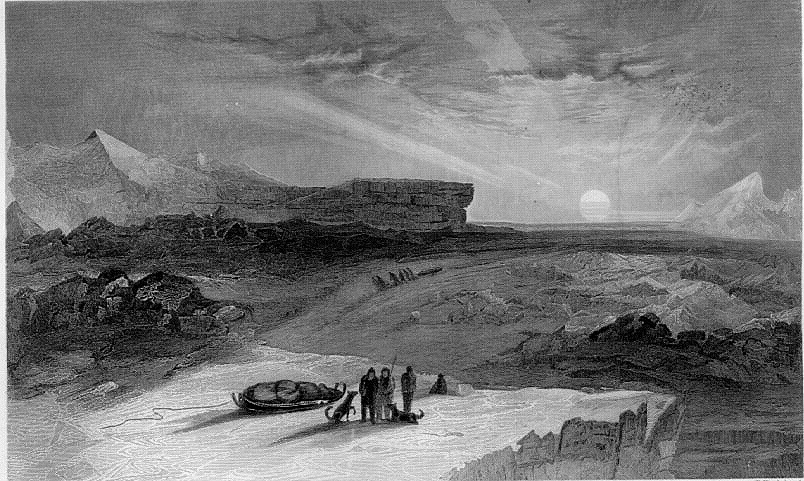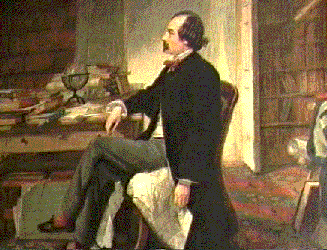
Dr. Elisha Kent Kane
Click here for an animation of the First Grinnell Expedition, 1851
Dr. Elisha Kent Kane
By Charles O. Cowing
December 2002
Elisha Kent Kane passed a relatively unremarkable childhood. The first-born child of a prominent Philadelphia judge and his beautiful socialite wife., Kane’s youth was one of quiet, cultured privilege. According to his contemporaneous biographer, William Elder, Kane was an average student, eventually accepted at the University of Virginia. In his second year of college he contracted rheumatic fever. This event, more than any other was to influence the rest of his life.
The immediate result of his illness was his attraction to the world of medicine. Upon his graduation from the University of Virginia, Kane began medical studies in Philadelphia. By twenty-two, he had published a study of early pregnancy detection in the American Journal of Medical Sciences. A more profound impact was produced by the residual persistent endocarditis left by the rheumatic fever. Without the benefit of antibiotics, it was the equivalent of a death sentence. Perhaps a couple of years would pass, perhaps a few decades, but the sentence was final.
Kane set out to live a life that would be remembered. Joining the U.S. Navy, he hoped to travel the world. His first engagement with the Navy was as physician to the U.S. legation led by Caleb Cushing, assigned to treaty negotiations with China in 1843. This posting afforded Kane travel to Madeira, Rio de Janeiro, Bombay, Ceylon, Macao Roads and Manila. He found himself in the Philippines, where he descended into the crater of an active volcano to retrieve water samples, much to the dismay of his companions, who fled the scene in mortal fear. Traveling to China, he practiced medicine on a hospital ship in Whampoa for several months before setting off to the west through India and Egypt, Athens and Paris.
Two more tours of stultifying naval duty sent him to an old family friend at the White House, then-Secretary of State James Buchanan, to beg for a more exciting tour of duty. President Polk assigned him to an extremely dangerous mission: to carry a message to the commander of American forces in Mexico City during the Mexican-American War. After Kane saved a Mexican general from being murdered by the very mercenaries hired to escort him, Kane emerged as an important figure at the international level.
Once again bored by navy duty, he wrote to the Secretary of War, proposing that he be included, as ship’s surgeon, on a mission to the Arctic to rescue a missing British explorer, Sir John Franklin. Two weeks later began the most remarkable chapters in Kane’s life as he set off to Lancaster Sound as ship’s surgeon with the First Grinnell Expedition, commanded by Lieutenant Edwin J. De Haven. The Advance and the Rescue departed New York Harbor on 22 May 1850. Searching for Franklin, they wintered in Wellington Channel. Kane was present at a meeting of several Franklin search parties on Beechey Island when three graves (exhumed and autopsied in 1984 by Owen Beattie) of Franklin crew were found.
Notwithstanding the challenges of scurvy and the depressing Arctic night, the men survived the experience well. After breaking free of the ice in early June, De Haven continued searching for Franklin on their way back to New York, where they docked on September 30, 1851.
From November 1851 through May 1853, Kane spoke often before large audiences (including three lectures at the fledgling Smithsonian in Washington, DC), as well as working furiously on a book on the first Grinnell Expedition. Additionally, he had time to fall in love with a celebrity psychic, Margaret Fox.
On 31 May 1853, the brig Advance sailed from New York Harbor under the command of Dr. Kane, headed for Smith Sound, racing to get there before Sir Edward Inglefield, travelling in Lady Jane Franklin’s steam-powered ship, Isabel. Kane and his men made it through Smith Sound and, by literally dragging the Advance thirty miles into what is now Kane Basin before being beset by the ice on 26 August. There they remained for twenty one months before abandoning the Advance and struggling back to Godhavn, Greenland, eight hundred miles to the south. Kane’s hugely successful book, Arctic Explorations, 1853, ’54, ’55 details the privations and hardships the survivors endured.
Although largely forgotten today, Elisha Kent Kane was an immensely popular figure in the latter half of the nineteenth century. It has been said that, if homesteaders heading west across the United States' frontier carried two books, one was certainly by Dr. Kane- the other was probably a Bible.
His rescue missions to the Arctic were widely regarded as suicidal. Inasmuch as his expeditions were validated by the goal of the discovery of the Open Polar Sea (a popular theory among scientists of the era,) his was a scientific as well as a cultural mandate. His published accounts held a nation spellbound.
The efforts connected with the writing of the account of his second mission (abetted by the "dragon within" of his chronic endocarditis) eventually killed him. Upon his death in Havana at the age of thirty-seven, the Governor of Cuba personally escorted the cortege as far as New Orleans. From New Orleans to Cincinnati, the banks of the Mississippi were lined with mourners, and the train trip from Cincinnati to Philadelphia took nearly four days because of the throngs on the tracks. His funeral was the largest in American history, eclipsed by Lincoln's a half decade later. Kane’s work in the Arctic marked the beginning of the United States’ seventy-five year growth to dominance in the field of Polar Exploration.
Biographical Data:
Elisha Kent Kane
E.K. Kane was born 3 February 1820; Philadelphia, PA to John Kintzing Kane, Attorney General, State of Pennsylvania 1845-1846, later Judge of U.S. District Court of Eastern Pennsylvania, J. K. Kane served the American Philosophical Society as Secretary, 1828-1848; as Vice-President 1848-1857, then as President 1858. J.K. Kane also served as Master of Franklin Lodge #128, Free and Accepted Masons.
E.K. Kane’s mother was Jane Duval Leiper Kane.
Kane attended the University of Virginia, 1837-1839, then enrolled as a medical student at the University of Pennsylvania, graduating in March, 1842.
Kane’s principal expeditions were the first Grinnell Expedition in search of SirJohn Franklin, 1851-1852, and the Second Grinnell Expedition, 1853-1855.
Kane’s publications include:
“Experiments on Kiestine with Remarks on its Application to the Diagnosis of Pregnancy, ” American Journal of Medical Sciences, n.s., 4 (1842)
United States Grinnell Expedition in Search of Sir John Franklin, A Personal Narrative, (New York: Harper, 1854)
Arctic Explorations, 1853, ’54, ’55, (Philadelphia, Childs and Peterson, 1856)
Although alleged by Margaret Fox to have proposed to her, no record of an actual marriage exists. Although anecdotes persist of a child born out of wedlock, no confirmed record can be found.
Kane died 16 February 1857 in Havana, Cuba of strokes, presumably brought on by endocarditis traceable to his bouts of rheumatic fever earlier in life.
Chas Cowing
December 2002

